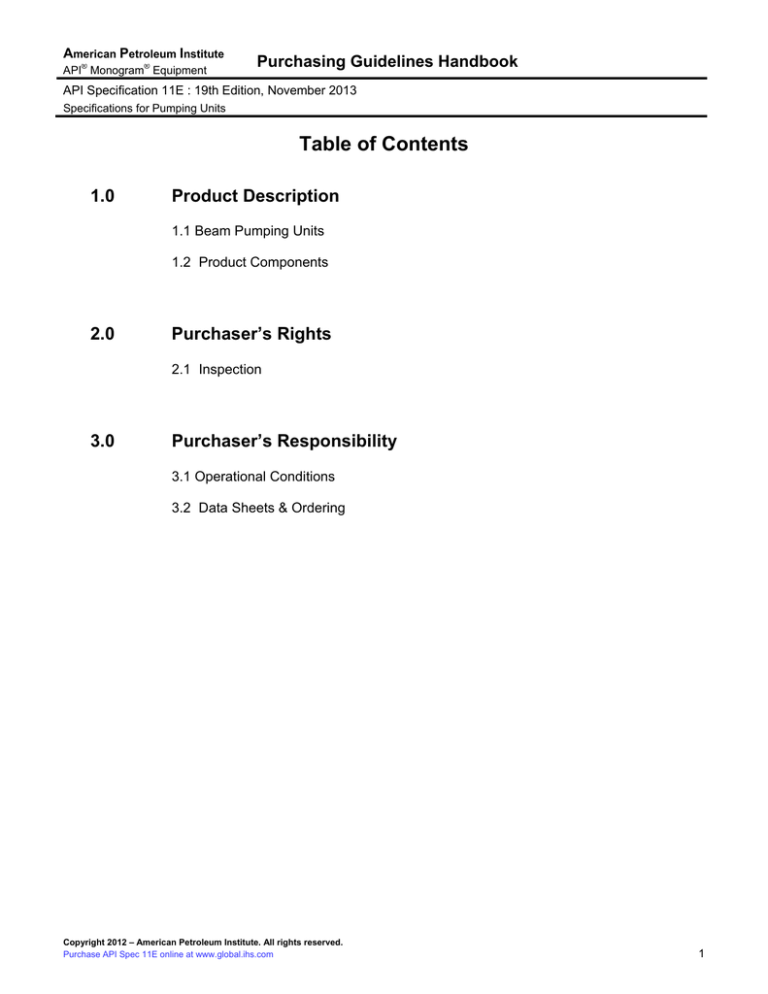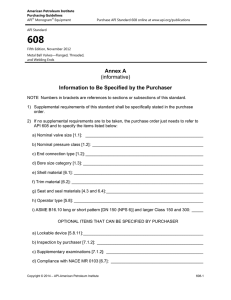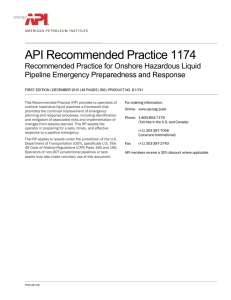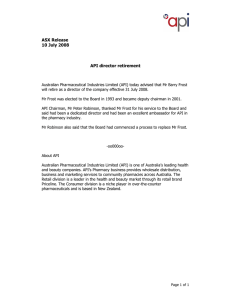
American Petroleum Institute
®
®
API Monogram Equipment
Purchasing Guidelines Handbook
API Specification 11E : 19th Edition, November 2013
Specifications for Pumping Units
Table of Contents
1.0
Product Description
1.1 Beam Pumping Units
1.2 Product Components
2.0
Purchaser’s Rights
2.1 Inspection
3.0
Purchaser’s Responsibility
3.1 Operational Conditions
3.2 Data Sheets & Ordering
Copyright 2012 – American Petroleum Institute. All rights reserved.
Purchase API Spec 11E online at www.global.ihs.com
1
American Petroleum Institute
®
®
API Monogram Equipment
Purchasing Guidelines Handbook
API Specification 11E : 19th Edition, November 2013
Specifications for Pumping Units
1.0
Product Description
Specification 11E includes the following requirements for product ordered and may be applicable in addition to any
product-specific requirements listed in other sections identified herein:
1.1
BEAM PUMPING UNITS
Product Description:
API Specification 11E– Introduction
Users of this Specification should be aware that requirements above
those outlined in this Specification may be needed for individual
applications. This Specification is not intended to inhibit a
manufacturer from offering, or the user/purchaser from accepting,
alternative equipment or engineering solutions. This may be
particularly applicable where there is innovative or developing
technology. Where an alternative is offered, the manufacturer should
identify any variations from this Specification and provide details.
1.2
PRODUCT COMPONENTS
Product:
Beam Pump Structure
Product Description:
API Specification 11E– 3.1.1
All components between the carrier bar and the speed reducer output
shaft.
Product:
Beam Pumping Unit
Product Description:
API Specification 11E– 3.1.2
Machine for translating rotary motion from a crankshaft to linear
reciprocating motion for the purpose of transferring mechanical
power to a downhole pump.
Product:
Horsehead
Product Description:
API Specification 11E– 3.1.13
Component of a beam pumping unit designed to transmit force
and motion from the walking beam to the flexible wireline.
NOTE
Its shape is such that the imparted motion is directed
vertically above the well headwellhead, allowing the polished rod to
move without undue side loads.
Copyright 2012 – American Petroleum Institute. All rights reserved.
Purchase API Spec 11E online at www.global.ihs.com
2
American Petroleum Institute
®
®
API Monogram Equipment
Purchasing Guidelines Handbook
API Specification 11E : 19th Edition, November 2013
Specifications for Pumping Units
Product:
Speed Reducer
Product Description:
API Specification 11E– 3.1.17
Mechanism located between the belt drive and the cranks to transmit
rotary power while reducing speed and increasing torque.
Product:
Beam Pumping Unit Nomenclature
Product Description:
API Specification 11E– Annex J Figure J.1
Copyright 2012 – American Petroleum Institute. All rights reserved.
Purchase API Spec 11E online at www.global.ihs.com
3
American Petroleum Institute
®
®
API Monogram Equipment
Purchasing Guidelines Handbook
API Specification 11E : 19th Edition, November 2013
Specifications for Pumping Units
2.0
PURCHASER’S RIGHTS
2.1
INSPECTION
Requirement:
API Specification 11E – 7.4.1
Where a user/purchaser appoints an inspector to verify the
manufacture, the inspector shall have unrestricted access to all
works related to the manufacture of items for the purchaser. The
manufacturer shall afford the inspector all reasonable facilities to
satisfy him that the material is being furnished in accordance with this
specification. Any inspection made at the place of manufacture shall
be considered process inspection and shall be conducted so as not
to interfere unnecessarily with the operation of the works.
Copyright 2012 – American Petroleum Institute. All rights reserved.
Purchase API Spec 11E online at www.global.ihs.com
4
American Petroleum Institute
®
®
API Monogram Equipment
Purchasing Guidelines Handbook
API Specification 11E : 19th Edition, November 2013
Specifications for Pumping Units
3.0
PURCHASER’S RESPONSIBILITY
3.1
OPERATIONAL CONDITIONS
Requirement:
API Specification 11E – 4.1
The user/purchaser shall determine the applicable well and
environmental operational conditions to order products which
conform to this specification, and specify the requirements and/or
identify the manufacturer’s specific products. These requirements
may be conveyed by means of dimensional drawing, datasheet, or
other suitable documentation.
To ensure proper interfaces with the other elements of the beam
pumping system such as the complete sucker rod string and the
downhole reciprocating pump, the following requirements shall be
specified:
a) required well lifting capacity by identification of the applicable
downhole pump;
b) required sucker rod size in alignment with well depth, rod design,
or other mechanical well parameters;
c) the total sucker rod string mass (weight) in the well;
d) potential extra loads due to the well configuration, friction, and
dynamic loading;
e) required gear configuration and resulting gear loading expressed
as gear reducing rating, defining the required lifting energy input;
f)
required load capability of the beam pump structure to
accommodate the sucker rod string weight and additional loads; and
g) the required maximum stroke length.
The combined requirements of gear reduction rating, structure
loading capacity, and maximum stroke length shall be used to identify
the specific beam pumping unit to be ordered as indicated by the
designation number provided in Annex B, Table B.1.
Requirement:
API Specification 11E – 4.2.2
For the torque on a reducer to be determined conveniently and
accurately from dynamometer test data, manufacturers of beam
pumping units shall, if requested by the purchaser, provide stroke
and torque factors for each 15° position of the crank. Figure C.2 is an
example form for recording this data.
Copyright 2012 – American Petroleum Institute. All rights reserved.
Purchase API Spec 11E online at www.global.ihs.com
5
American Petroleum Institute
®
®
API Monogram Equipment
Purchasing Guidelines Handbook
API Specification 11E : 19th Edition, November 2013
Specifications for Pumping Units
Requirement:
API Specification 11E – 6.2.3.2.4
The allowable static torque rating determined using this formula is
conservative since the geometry factor Jb includes a stress
concentration factor for fatigue. It should be noted that some gear
materials do not have a well-defined yield point and the ultimate
strength is approximately equal to the yield. For these materials, a
much lower value of Ky shall be selected. The user of this
specification should satisfy themself that the yield values selected are
appropriate for the materials used.
Requirement:
API Specification 11E – Annex I
A beam pumping system analysis will indicate whether the calculated
loading on the gear reducer is within the design limits for which it is
offered. This analysis is the responsibility of the user/purchaser.
Requirement:
API Specification 11E – Annex I
Methods of computing or of measuring well loads are not within the
scope of this specification; however, it is recommended to use API
11L to predict approximate polished rod loads and gear reducer
torque values. The user should be cognizant of the possibility of
actual loads exceeding apparent loads under one or more of the
following conditions:
a)
b)
c)
d)
e)
improper counterbalancing,
excessive fluctuation in engine power output,
serious critical vibrations of the reducer and engine system,
poor bottomhole pump operation, and
looseness in the beam pump structure.
Copyright 2012 – American Petroleum Institute. All rights reserved.
Purchase API Spec 11E online at www.global.ihs.com
6
American Petroleum Institute
®
®
API Monogram Equipment
Purchasing Guidelines Handbook
API Specification 11E : 19th Edition, November 2013
Specifications for Pumping Units
Requirement:
API Specification 11E – Annex B
Copyright 2012 – American Petroleum Institute. All rights reserved.
Purchase API Spec 11E online at www.global.ihs.com
7
American Petroleum Institute
®
®
API Monogram Equipment
Purchasing Guidelines Handbook
API Specification 11E : 19th Edition, November 2013
Specifications for Pumping Units
Copyright 2012 – American Petroleum Institute. All rights reserved.
Purchase API Spec 11E online at www.global.ihs.com
8
American Petroleum Institute
®
®
API Monogram Equipment
Purchasing Guidelines Handbook
API Specification 11E : 19th Edition, November 2013
Specifications for Pumping Units
3.2
DATA SHEETS & ORDERING
Requirement:
API Specification 11E – Annex C
Name of
manufacturer
Date prepared
Designation of unit
Description a
Total Weight
[lb (N)]
Maximum
Moment About
Crankshaft b
[in.-lb (Nm)]
a
Describe parts in use accurately enough to avoid any possible misunderstanding, showing on separate lines
a series of practical combinations from minimum to maximum.
b
Equals total weight (column 2) times distance to center of gravity, with crank in horizontal position.
Figure C.1—Rating Form for Crank Counterbalances
Copyright 2012 – American Petroleum Institute. All rights reserved.
Purchase API Spec 11E online at www.global.ihs.com
9
American Petroleum Institute
®
®
API Monogram Equipment
Purchasing Guidelines Handbook
API Specification 11E : 19th Edition, November 2013
Specifications for Pumping Units
Name of manufacturer
Date Prepared
Designation of unit
Pumping unit structural imbalance
Position of
a
Crank
(degrees)
Pounds
Position of Rods
b
Length of Stroke [in. (mm)]
Torque Factor
c
Length of Stroke [in. (mm)]
0°
15°
30°
45°
60°
75°
90°
105°
120°
135°
150°
165°
180°
195°
210°
225°
240°
255°
270°
285°
300°
315°
330°
345°
A
P
C
K
R1
H
R2
I
R3
G
a
For crank counterbalance units with Class I geometry, the position of the crank is the angular displacement measured clockwise from
the 12 o’clock position, viewed with the wellhead to the right. For crank counterbalanced units with Class III geometry, the position of the
crank is the angular displacement measured counterclockwise from the 6 o’clock position, viewed with the wellhead to the right. For air
counterbalanced units with Class III geometry, the position of the crank is the angular displacement measured clockwise from the 6 o’clock
position, viewed with the wellhead to the right.
b
c
Position is expressed as a fraction of stroke above lowermost position.
Torque factor =
NOTE
T
, where T = torque on pumping unit reducer due to polished rod load PR.
PR
See Annex D, Annex E, Annex F, or Annex G for symbol identification.
Figure C.2—Pumping Unit Stroke and Torque Factor Form
Copyright 2012 – American Petroleum Institute. All rights reserved.
Purchase API Spec 11E online at www.global.ihs.com
10
American Petroleum Institute
®
®
API Monogram Equipment
Purchasing Guidelines Handbook
API Specification 11E : 19th Edition, November 2013
Specifications for Pumping Units
Manufactured by:
Date submitted
Nominal reducer size
Calculated Values
Pitting resistance torque
Static torque
First reduction
in.-lb (Nm)
Second reduction
in.-lb (Nm)
Third reduction
in.-lb (Nm)
Bending strength torque
Units:
Pinion
in.-lb
(Nm)
in.-lb
(Nm)
Pinion
in.-lb
(Nm)
in.-lb
(Nm)
Pinion
in.-lb
(Nm)
in.-lb
(Nm)
Gear
Second reduction:
Gear
First reduction:
Gear
First reduction:
Third reduction:
in.-lb (Nm)
Pinion
in.-lb (Nm)
in.-lb (Nm)
Pinion
in.-lb (Nm)
in.-lb (Nm)
Pinion
in.-lb (Nm)
Gear
Second reduction:
Gear
Third reduction:
Gear
Notes:
1. First reduction is high-speed reduction.
2. Second reduction is slow-speed reduction on double reduction gear reducers and the intermediate reduction on triple reduction gear
reducers.
3. Third reduction is the slow-speed reduction on triple reduction reducers and is not applicable on double reduction reducers.
Construction Features
Type of reducer (Cross out if not applicable)
(Single)
(Double)
(Triple) Reduction
(Single)
(Double)
Helical gearing
Teeth
Number of teeth and normal diametral pitch or transverse diametral pitch:
First reduction
Np
Ng
Pnd
(mn)
Pd
(m)
Second reduction
Np
Ng
Pnd
(mn)
Pd
(m)
Third reduction
Np
Ng
Pnd
(mn)
Pd
(m)
Center distance and net face width:
First reduction
CD
F
Second reduction
CD
F
Third reduction
CD
F
Figure C.3—Manufacturer’s Gear Reducer Datasheet
Copyright 2012 – American Petroleum Institute. All rights reserved.
Purchase API Spec 11E online at www.global.ihs.com
11
American Petroleum Institute
®
®
API Monogram Equipment
Purchasing Guidelines Handbook
API Specification 11E : 19th Edition, November 2013
Specifications for Pumping Units
Helix angle and normal pressure angle or transverse pressure angle (degrees):
First reduction
n
t
Second reduction
n
t
Third reduction
n
t
Geometry factors, I and J (for pinion and gear)
First reduction geometry factor
I
JP
JG
Second reduction geometry factor
I
JP
JG
Third reduction geometry factor
I
JP
JG
Manufacturing methods
Teeth generated by
process
Teeth finished by
process
Tooth hardening method
Gear and pinion materials and hardness
First reduction
Gear material
Surface BHC/Rc
Core BNH
a
Pinion material
Surface BHC/Rc
Core BNH
a
Gear material
Surface BHC/Rc
Core BNH
a
Pinion material
Surface BHC/Rc
Core BNH
a
Gear material
Surface BHC/Rc
Core BNH
a
Pinion material
Surface BHC/Rc
Core BNH
a
Second reduction
Third reduction
Other components
Crankshaft material
Hardness
Housing material
Housing type (Check):
Split
Bearing sizes b
One piece
Bearing loading d
High speed pinion
High speed pinion
Intermediate speed pinion
c
Intermediate speed pinion c
Low speed pinion
Low speed pinion
Low speed gear
Low speed gear
a
Core hardness required for surface hardened gears and pinions only.
For journal bearings indicate projected area; for roller bearings indicate the American Bearing Manufacturer’s Association (or equivalent)
size. List all bearings on each shaft (state if bearings are mounted in carriers or directly in gear housing).
c
Not applicable on double reduction reducers.
d
For journal bearings, list loading on each bearing. For roller bearings, list L-10 life as calculated in 6.4.4.
b
Figure C.3—Manufacturer’s Gear Reducer Datasheet (continued)
Copyright 2012 – American Petroleum Institute. All rights reserved.
Purchase API Spec 11E online at www.global.ihs.com
12




![Subject Line: Dear [insert name of manager],](http://s2.studylib.net/store/data/017768406_1-c50aef4b9b58b03a50d5284bdf8bfcdd-300x300.png)

